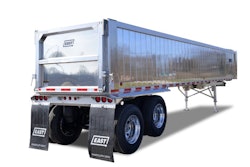The new federal hours of service (HOS) rules have the potential to advance highway safety though better fatigue management. However, we must recognize that any regulation, no matter how well-intended, merely establishes the minimum needed to squeak by. To achieve real results, trucking companies and professional drivers must look beyond compliance to the behaviors that truly drive safety.
 Brian Fielkow is CEO of Houston-based Jetco Delivery and Executive Vice President of Montreal-based The GTI Group.
Brian Fielkow is CEO of Houston-based Jetco Delivery and Executive Vice President of Montreal-based The GTI Group.The new rules announced by the Federal Motor Carrier Association (FMCSA) become effective Sept. 29, 2020 and provide much-needed flexibility to our country’s professional truck drivers to better manage fatigue. The FMSCA, listening carefully to many stakeholders, took more than two years to develop these rules.
Under current HOS rules, a driver may work 14 hours before taking a mandatory 10-hour break. Once the duty clock has started, a driver may not pause the clock. So, if a driver is tired and needs to pull over for a nap or extended break, there is a disincentive because the driver loses valuable duty hours. Most drivers are paid on productivity and therefore might be reluctant to pull over for a few hours of rest.
Under the new HOS rules, a driver may split his/her 10-hour break into two breaks of 7 hours/3 hours or 8 hours/2 hours. This revision allows the driver to pause the clock.
Earlier this month, a House highway bill was introduced. One of the bill’s provisions is to stop the new HOS rules from taking effect pending exhaustive studies and reviews. The bill could delay the new rules for years. Critics of the new HOS rules worry that some bad actors will use the new rules to push drivers to their limits.
It’s nonsense to think that we should delay progress on meaningful safety reform because of bad actors. There is a segment of the trucking industry that certainly will cheat under the new HOS rules, just as they are cheating under the current ones.
We must ramp up enforcement against the cheaters, with the objective of driving bad companies and bad drivers out of the industry. Trucking companies must be a part of the enforcement solution. We must eliminate rogue operators from our ranks. If we look the other way, we are part of the problem. If we truly want to raise the bar on safety, we cannot regulate to the lowest common denominator.
Moreover, when it comes to safety, traditional “labor vs. management” thinking is destructive. Entire organizations must pull in the same direction. The best companies have created organizational alignment around safety. They know safety and productivity are not in conflict with each other and that the safest companies are the most productive. These companies understand that their safety mission is never accomplished. Safety is about continuous improvement.
The new HOS rules provide industry players with a powerful tool to improve safety by allowing professional drivers to manage their fatigue. Having the ability to stop the clock creates an incentive for drivers to rest because they can pause their duty cycle. They also can stop for bad weather or rush hour traffic, thereby avoiding the most stressful driving conditions. Under real-world application of the current rules, drivers are incentivized to keep pushing.
The new rules recognize that you can regulate hours but you cannot regulate fatigue. Fatigue management is about listening to your body — knowing when it is time to recharge. Fatigue management is about using good judgment and having the flexibility to do so.
With greater flexibility comes increased individual and organizational accountability. Drivers must be individually accountable to use breaks for their intended purpose, and face consequences if they abuse their break time. Consider the infamous 2014 truck incident involving comedian Tracy Morgan. The truck driver in that case had been awake for 28 hours, having driven 12 hours in his personal vehicle before beginning his shift. It is difficult for employers to know what their drivers are doing in their off-hours. Drivers must hold themselves to the highest possible standard.
Trucking companies must be organizationally accountable for driver and public safety. We must unconditionally allow a driver to pause the clock for a break under the new HOS rules. We cannot allow production pressure to interfere with a driver’s need to manage fatigue. We must not dissuade a driver from pausing the clock regardless of the urgency of the shipment.
Accountable companies understand that just because they are compliant does not mean they are safe. Regulations, at best, provide only the minimum to get by. Take this example: Assume that a driver comes to work feeling very sick. The driver may have 14 legal duty hours available. The driver is compliant. From a safety standpoint, however, the driver should not work. You simply cannot regulate this scenario or thousands of similar ones. True safety is more about behavior, judgment and accountability than technical regulations.
The new HOS rules allow accountable companies and drivers to work smarter – driving slower during rush hour traffic or inclement weather and obtaining much-needed rest mid-cycle. Delaying the new HOS rules accomplishes nothing and deprives the industry of the opportunity to better manage fatigue.
The trucking industry must capture this opportunity. We have a duty to our drivers and the public. FMCSA has provided trucking companies and professional drivers with tools to become safer. We must get it right. There will not be a second chance.
Brian Fielkow is CEO of Houston-based Jetco Delivery and Executive Vice President of Montreal-based The GTI Group. He is co-author of Leading People Safely; How to Win on the Business Battlefield. Fielkow received the National Safety Council’s Distinguished Service to Safety Award, the council’s highest-level individual recognition.













